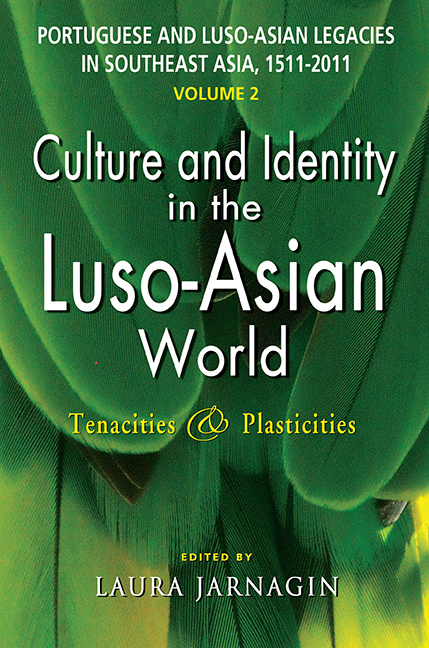 Portuguese and Luso-Asian Legacies in Southeast Asia, 1511-2011, vol. 2
Portuguese and Luso-Asian Legacies in Southeast Asia, 1511-2011, vol. 2 Book contents
- Frontmatter
- Contents
- List of Figures and Tables
- Preface
- List of Contributors
- Glossary
- Introduction: The Qualitative Properties of Cultures and Identities
- Part One Crafting Identity in the Luso-Asian World
- Part Two Cultural Components: Language, Architecture and Music
- 5 The Creole-Portuguese Language of Malacca: A Delicate Ecology
- 6 Oral Traditions of the Luso-Asian Communities: Local, Regional and Continental
- 7 Verb Markings in Makista: Continuity/Discontinuity and Accommodation
- 8 From European-Asian Conflict to Cultural Heritage: Identification of Portuguese and Spanish Forts on Ternate and Tidore Islands
- 9 The Influence of Portuguese Musical Culture in Southeast Asia in the Sixteenth and Seventeenth Centuries
- Part Three Adversity and Accommodation
- Appendix: Maps
- Bibliography
- Index
- Titles in the Nalanda-Sriwijaya Studies Centre Series
8 - From European-Asian Conflict to Cultural Heritage: Identification of Portuguese and Spanish Forts on Ternate and Tidore Islands
from Part Two - Cultural Components: Language, Architecture and Music
Published online by Cambridge University Press: 21 October 2015
- Frontmatter
- Contents
- List of Figures and Tables
- Preface
- List of Contributors
- Glossary
- Introduction: The Qualitative Properties of Cultures and Identities
- Part One Crafting Identity in the Luso-Asian World
- Part Two Cultural Components: Language, Architecture and Music
- 5 The Creole-Portuguese Language of Malacca: A Delicate Ecology
- 6 Oral Traditions of the Luso-Asian Communities: Local, Regional and Continental
- 7 Verb Markings in Makista: Continuity/Discontinuity and Accommodation
- 8 From European-Asian Conflict to Cultural Heritage: Identification of Portuguese and Spanish Forts on Ternate and Tidore Islands
- 9 The Influence of Portuguese Musical Culture in Southeast Asia in the Sixteenth and Seventeenth Centuries
- Part Three Adversity and Accommodation
- Appendix: Maps
- Bibliography
- Index
- Titles in the Nalanda-Sriwijaya Studies Centre Series
Summary
When one thinks about the Portuguese fortifications in the Malay Archipelago, what immediately come to mind are such images as Malacca's Famosa or Fort Vitoria on the island of Ambon. Given their prominance, it is not an easy task to present new materials concerning these two Portuguese fortresses. By contrast, several other forts in the region that were built up by the Portuguese and the Spaniards over the course of about a century are not sufficiently known, even to historians dealing with Southeast Asia in the modern age. Actually, the Iberian historical and cultural legacy in the Malay Archipelago includes a number of fortifications and remains of fortifications throughout the Northern Maluku islands, especially those on the islands of Ternate and Tidore. In these locations, the Portuguese forts date from between 1522 and 1603; those of Spanish origin date from 1606 onwards, when the Maluku islands, as part of the Portuguese empire in Asia, or the Estado da Índia, were incorporated into the Philippines. The Spanish abandoned Maluku in 1663, but there is no indication that they built any new fortifications after 1637. The forts and ruins of forts are scattered throughout the islands of Ternate, Tidore, Halmahera, Bacan, Seram and Ambon where more than twenty Iberian archaeological sites can be identified out of a total of ninety-six forts built in the region by local rulers, Europeans and Japanese.
This heritage was virtually forgotten until recent times by both Portuguese and Spanish historiographies. In the late 1980s, Florentino Rodao, a Spanish historian, in an article illustrated by photos of forts on Ternate and a map displaying their location, made the first attempt to positively identify such forts and their ruins by direct observation and across literary materials. During the nineteenth century, some Dutch historians and erudite colonial officers worked on this architectural patrimony based upon records and reports produced by representatives and administrators of the Vereenigde Oost-Indische Compagnie (VOC), or Dutch East India Company.
- Type
- Chapter
- Information
- Portuguese and Luso-Asian Legacies in Southeast Asia, 1511-2011, vol. 2Culture and Identity in the Luso-Asian World: Tenacities & Plasticities, pp. 179 - 207Publisher: ISEAS–Yusof Ishak InstitutePrint publication year: 2012


